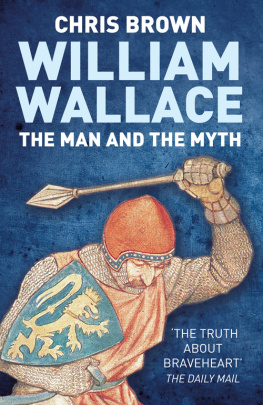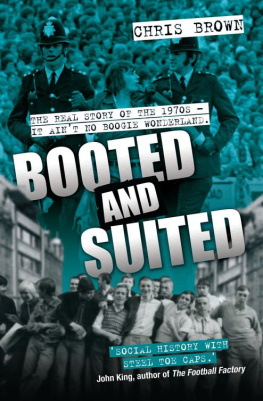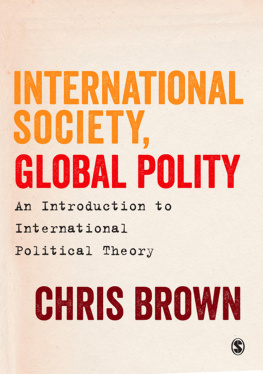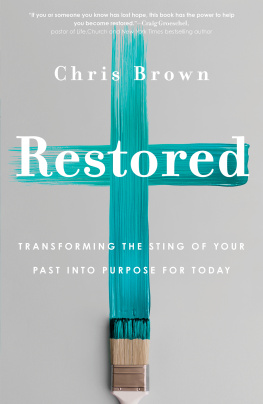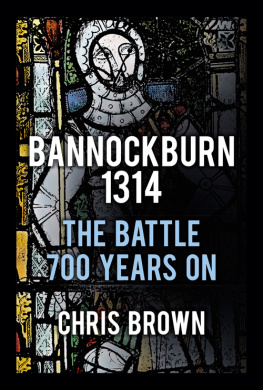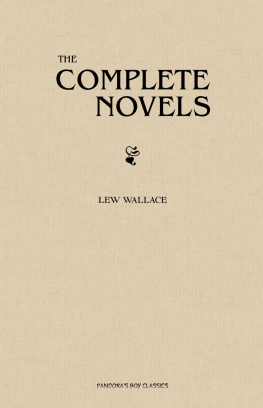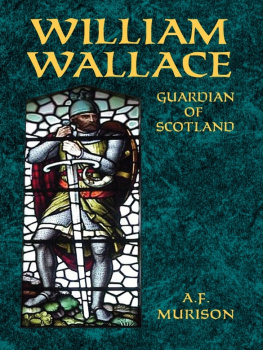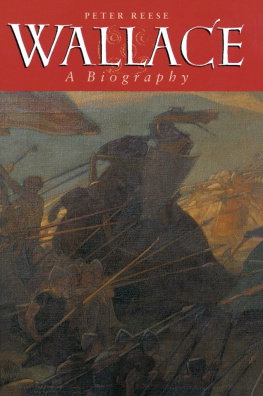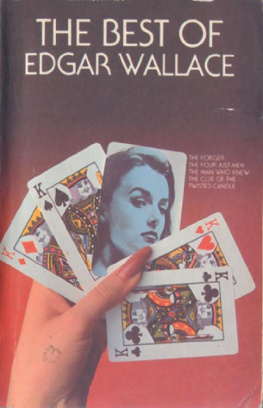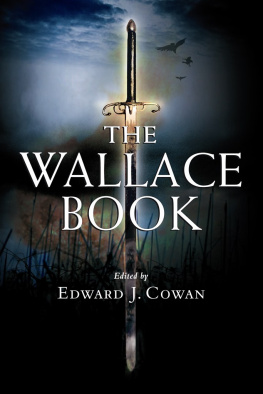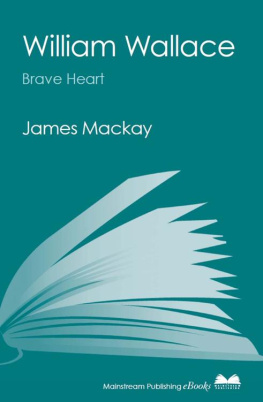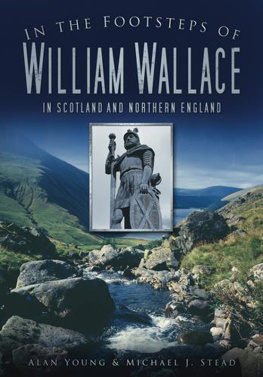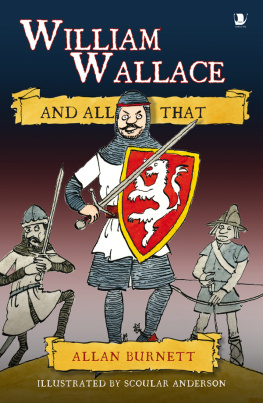
As ever, pride of place goes to my wife Pat, who has suffered the life and times of William Wallace with a stoical grace, and to my children Charis, Christopher, Colin and Robert and my parents Peter and Margaret, who have also been subjected to more Wallace than is fair to ask of anyone. Yet again, Robert has rescued me from self-inflicted computer disasters. Friends at St Andrews University Scottish History Department have given me a great deal of their time Dr William Knox, Mr Alex Woolf, and others too numerous to mention I am grateful to them all. To the staff of Easy PCs of Kennoway for their help in making the manuscript file printable, and to the late Kay Urquhart, good friend, good company and the mainstay of my babysitting in the days when I was a single parent. I am particularly indebted to Professor G.W.S. Barrow, who very kindly read the unedited manuscript of this book and made many valuable corrections and suggestions. This was my fourth book. I had expected that I would have found an effective and reliable means of blaming others for my mistakes it is a tragedy that I have still not yet been able to do so, but hopefully I have managed to remove the majority of them now.
CONTENTS
Since this is a revised edition I have taken the opportunity to correct a number of mistakes and make some clarification, but also to reduce the size of the volume by removing the examination and analysis of the source material which took up a great deal of space and was only of any interest to those of a scholarly inclination, which is a courteous way of saying total history anoraks such as myself. All of the record and narrative material is available in printed form and should be accessible through any local authority or university library, through the inter-library loan scheme.
The purpose of this book is to provide a context for Sir William Wallace, one of the most remarkable men of medieval Europe. It concentrates on the themes that were most significant to Wallace and his contemporaries service and allegiance. These issues were inextricably linked to status, landholding and political activity. In the environment of Scotland in the later thirteenth and early fourteenth centuries the chief focus of that activity was war, and therefore a great deal of this book is about the nature of military service, campaigning and battles. Nobody chose to make a detailed study of the Scottish military structure in Wallaces lifetime, so some of the material is drawn from the much greater though by no means complete data we have for the armies and practices of Robert I, but there is no reason for us to think that these were significantly different. Without the conflict brought about by Edward I, Wallace would almost certainly have never come to prominence; he would have been no more significant and no better known than any of the thousands of younger sons of obscure minor landholders who only appear very fleetingly and most of them not at all in the surviving records. Although there is very little information on any particular one of Wallaces contemporaries and social equals, there is a good deal of material about a large number of them scattered through narrative and record evidence; by looking at these as a whole we can get a picture of the rights and responsibilities of these men, and the issues that they had to deal with if they were to preserve themselves and their heritage through very challenging times. If this book can help the reader toward a better understanding of William Wallace and the society in which he lived it will have served its purpose.
Perhaps the ultimate Scottish hero, Wallace has been dear to the hearts of Scots and others, of all ages, classes, political and religious persuasions, for seven centuries. His determination has been used to inspire soldiers, athletes and political movements. His life has inspired novelists, poets, songwriters and film-makers. A brief survey of the World Wide Web indicates a vast interest in the man, with more than one million entries for Sir William Wallace. By the same measure, it could be argued that the public interest in Braveheart is rather stronger, since there are more than twice as many websites dedicated to the Mel Gibson portrayal of the Guardians political career.
Wallace has been the subject of a great many Victorian statues of questionable artistic value, several novels, at least one stage play, a film, a strip cartoon book and a number of popular, if somewhat fanciful, biographies. All of these have been the work of people who have been enthused and inspired (understandably) by the life of one of the greatest, if not the greatest, of Scotlands heroes. Novels, films, plays and cartoons share a common factor: nobody expects them to be strictly realistic portrayals of personalities, events or conditions they are fantasies devised for entertainment. It could be argued, with some justice, that the latter statement also applies to the bulk of the biographies of William Wallace that have appeared in recent years.
For several writers the starting point, mainstay and in at least one example the entirety of their primary research has been the study of Blind Harrys The Wallace epic. Whether the poem is a great work of fifteenth-century literature or nothing more than sheer hagiography in doggerel verse is open to debate; whether it is a generally useful record of the life and work of William Wallace is not. Harrys claim to have used an existing biography of Wallace written by his chaplain, Blair, may be true, but that does not mean that the Blair manuscript, assuming that it ever existed, bore any great resemblance either to Blind Harrys eulogy or the life of Wallace. The shortcomings of The Wallace as a historical record have been demonstrated many times and need no rehearsal here; what is more of an issue is the manner in which Wallaces life has been approached. Since few, if any, of the Wallace biographers have made any serious examination of the social, cultural, economic, political or military conditions of the lesser nobility in either Scotland or England in the late medieval period, they have been prone to assumptions and perhaps a spot of wishful thinking about the nature of the society in which William Wallace grew up and in which he made his career.
It has, for example, become an article of faith among Scots that Wallace was a man of the common people, separated from a privileged, foreign and oppressive noble class by language and social ethos. Nothing could be further from the truth. William Wallace was a product of the Scottish noble class, not an enemy of it, and not distanced from it in any cultural or political sense. but that does not have the same romantic appeal as the struggle of a man to overcome the prejudice and ineffectiveness of a class of aristocratic chancers, which is, broadly, the view offered in several recent biographies. The origin of the recent spate of Wallace books is, to a considerable extent, a product of the success of the Braveheart film it is, as they say, an ill wind However, there has been a steady rise in interest in medieval Scotland among historians over the last forty years and much of the credit for that must go to Professors Geoffrey Barrow, Ranald Nicholson and Archibald Duncan, very much the architects of current thinking relating to Scotland in the later Middle Ages.
In 1965 Professor Barrow published the first scholarly examination of the life and reign of Robert I. Entitled Robert the Bruce and the Community of the Realm of Scotland , it was revolutionary in that it was a formal political biography of a Scottish king, not a collection of tales and traditions. In the same year, Professor Nicholson published Edward III and the Scots, the Formative Years of a Military Career , a detailed study of the final attempt of Plantagenet kings to bring Scotland directly under their sway. Both Barrow and Nicholson discovered that a great deal of light could be cast on affairs in Scotland through the study of English state records. In a sense this had been long recognised. In the late nineteenth century the Reverend Stevenson and Joseph Bain published collections of material connected with Scottish affairs. These volumes, Documents Illustrative of the History of Scotland and Calendar of Documents Relating to Scotland , have provided medievalists with a wonderful resource for over 100 years. Neither Bain nor Stevenson was an analytical historian so much as an antiquarian, and Bains lengthy introductions to each of the four volumes he compiled have not lasted the test of time so well as the body of the work. There is no such thing as a perfect work of history and both Bain and Stevenson misdated or misinterpreted the significance, or sometimes the origin, of the odd document here and there, but their scholarship and industry have been a boon to anybody and everybody with an interest in medieval Scotland.
Next page
